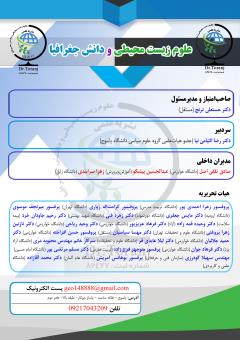تحلیل محتواي کتاب هاي فارسی نیمه دوم دوره ابتدایی (پایه هاي ششم)
محورهای موضوعی : Planning scienceایوب سعادت مهر 1 , زکیه دستمرد 2
1 - دانشگاه فرهنگیان شیراز
2 - دانشگاه یاسوج
کلید واژه: تحلیل محتوا, کتاب فارسی, پایه ابتدایی, عوامل خلاقیت گیلفورد, حافظه شناختی,
چکیده مقاله :
هدف اصلی از پژوهش حاضر تحلیل محتواي کتاب هاي فارسی نیمه دوم دوره ابتدایی (پایه ششم) براساس عوامل خلاقیت گیلفورد بوده است. براساس جامعه آماري کتاب فارسی تعیین گردیده است و ابزار اندازه گیري، محتواي دو کتاب فارسی یعنی کتاب خوانداري و نوشتاري (در پایه ششم) و فرم محقق ساخته میباشد. به منظور تحلیل محتوا از روش واحد ثبت در زمینه استفاده شده است و با استفاده از جداول، فراوانی و درصد به توصیف و تحلیل داده ها پرداخته شده است. روایی ابزار اندازه گیري از طریق فرمول در پایه ششم توافق و پایایی ابزار براساس روش ضریب توافق زمانی طی سه ماه متوالی با انجام پذیرفت. تحلیل و تفسیر داده ها براساس spss استفاده از فرمول همبستگی پیرسون و نرم افزار شاخص هاي آمار توصیفی و از فرمول آزمون تفاوت فراوانی با اتکا بر فرمول کاي اسکوئر (خی دو) تک متغیر مورد تحلیل قرار گرفت. نتایج این پژوهش نشان داد که: بیشتر محتوا و تصاویر کتاب هاي فارسی (خوانداري و نوشتاري) هر سه پایه در سطح حافظه شناختی قرار دارند و به سطح تفکر واگرا و ارزشیاب کمتر توجه شده است. در پایه ششم سطح تفکر همگرا، حافظه شناختی و تفکر واگرا از تعادل نسبتاً خوبی برخوردار می باشد لازم به ذکر است در مورد عناصر واگرا: پایه پنجم در فعالیت هاي خوانداري و تمرینات نوشتاري بیشتر در سطح اصالت و محتوا در سطح روانی؛ و محتوا، فعالیت ها و تمرینات و تصاویر خوانداري و نوشتاري ششم بیشتر در سطح روانی طراحی شده است.
The main goal of the current research was to analyze the content of Persian books in the second half of the elementary school (sixth grade) based on Guilford's creativity factors. Based on the statistical society, the Persian book has been determined and the measurement tool is the content of two Persian books, i.e. reading and writing books (in the sixth grade) and the researcher-made form. In order to analyze the content, the single registration method has been used in the field, and the data has been described and analyzed using tables, frequency and percentage. The validity of the measurement tool was accepted through the formula in the sixth grade, and the reliability of the tool was accepted based on the time agreement coefficient method during three consecutive months. Analysis and interpretation of data based on spss using Pearson's correlation formula and descriptive statistics index software and frequency difference test formula was analyzed by relying on chi-square (chi-square) single variable formula. The results of this research showed that: Most of the content and images of Persian books (reading and writing) of all three grades are at the level of cognitive memory, and less attention has been paid to the level of divergent and evaluative thinking. In the sixth grade, the level of convergent thinking, cognitive memory, and divergent thinking has a relatively good balance. It should be mentioned about the divergent elements: the fifth grade has more reading activities and writing exercises at the level of originality and content at the psychological level; And the sixth reading and writing content, activities, exercises and pictures are designed more on the psychological level.
• شعباني ، زهرا، ( 1383 ) بررسي تطبيقي برنامه ي تربيت معلم ايران و چند كشور جهان، فصلنامه ي تعليم و تربيت، سال بيستم، شماره 3، پائيز.
• طرح كليات نظام آموزش و پرورش جمهوري اسلامي ايران ( 1367 ) وزارت آموزش و پرورش،خرداد ماه.
• ملكي، حسن ( 1380 ) ، صلاحيت هاي حرفه اي معلم، تهران، انتشارات مدرسه.
• وزارت آموزش و پرورش ( 1381 ) آئين نامه ها و مقررات مربوط به تربيت معلم، تهران، معاونت نيروي انساني.
• وزارت آموزش و پرورش ( 1382 ) مجموعه مصوبات شوراي عالي آموزش و پرورش، تهران،انتشارت مدرسه.
• يونيسف، تربيت معلم به سوي الگويي تازه براي معلمان، ( 1377 ) ترجمه فريبرز مجيدي،پژوهشكده تعليم و تربيت، چاپ اول.


